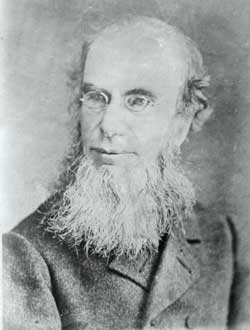
Council of Heads of Australasian Herbaria
Australian National Herbarium
Biographical Notes
 |
Council of Heads of Australasian Herbaria |
 Knight, Charles (1808 - 1891)
Knight, Charles (1808 - 1891) Born ? (baptised 14 July 1808) in Sussex, UK. Died in Wellington, NZ, 3 September 1891
Charles Knight was baptised at Rye, Sussex, England, on 14 July 1808, the youngest child of James and Ann Knight. His father died in 1808 and in 1810 his mother married Thomas Godfrey of Hawkhurst, Kent. In October 1828 Knight enrolled at University College, London, and during the next two years studied medicine. Between 1830 and 1840 little is known of him except that he practised medicine in the United States. He became an MRCS in 1840 (and FRCS in 1869).
Early in 1841 Knight left England as surgeon on the Lord Glenelg , the ship taking George Grey to Adelaide as governor of South Australia. Towards the end of the voyage the ship's captain became increasingly drunk and violent towards passengers and crew, and Knight took over navigation. He later described his own 'singular metamorphosis from Surgeon into Captain of that vessel and how I navigated her from King George's Sound to this port in perfect safety'. Knight was employed by Grey as a copying clerk, and by 1843 was working in the private secretary's office at a salary of £200. Grey liked Knight's 'cheerfulness and unwearying industry'. On 6 March 1844 at Adelaide, Knight married Caroline Symes. They had a family of two sons and three daughters.
In November 1845 Grey became governor of New Zealand. Knight accompanied him to Auckland on the Elphinstone and was appointed auditor general in February 1846. In 1855 he became manager of the Colonial Bank of Issue at Auckland, and in 1858 was made auditor of the public accounts of the general government. This last office was, in Knight's words, 'a patent one; so that I can devote all my own time to favourite pursuits without anxiety for the future'. As auditor of public accounts Knight investigated the charges against James Macandrew, superintendent of Otago province, in 1861, and two years later sat on a commission concerned with the development of flax processing. From 1861 Knight was in charge of meteorological observations, and set up 10 meteorological stations between Foveaux Strait and Mangonui. In 1865 he chaired a commission which recommended that the meteorological services be transferred from Knight's control to James Hector of the Geological Survey.
In mid 1865 Knight moved to Wellington. In 1866 he chaired a civil service commission which inquired into conditions of employment for public servants, and in 1867 brought the post office's money order and savings bank scheme into operation. In 1868 he visited England with Grey, and in 1869 went to Australia with Julius Vogel to negotiate a mail and customs agreement. Together with J. E. FitzGerald he was made a commissioner of audit in 1872. He retired in 1878 with an annual pension of £600. Knight's love of exact measurement and his inexhaustible appetite for routine and correct procedure made him a widely respected public servant.
Knight was also a dedicated botanist, using the hours before breakfast for his work. In 1852 he sent drawings of Auckland mosses to the Royal Botanic Gardens, Kew. These were warmly received, and he began work in 1856 on lichens, his principal botanical interest. He was elected a fellow of the Linnean Society in 1857, after being proposed by W. J. and J. D. Hooker and Andrew Sinclair. Between 1860 and 1884 Knight published 16 papers on lichens, 2 on mosses and 1 each in zoology and palaeontology. Although he was restricted by official duties, he took whatever collecting opportunities offered, making trips into the Nelson mountains with David Monro and W. T. L. Travers. He worked at Kew for periods during 1868 and 1869, and exchanged information with the leading European lichenologists.
Using his strong political and scientific contacts Knight promoted New Zealand botany with vigour and determination. He corresponded with Joseph Hooker at Kew over 30 years, and obtained a government commission of £600 in 1863 for Hooker to prepare a Handbook of the New Zealand flora (London, 1864--67). Knight also allowed the results of his own investigations to be made available for the use of scientists in New Zealand and overseas. His lichen collection of around 290 volumes is now in the National Museum in Wellington, his reprints are in the library of Botany Division, DSIR, his lichen library is at Victoria University of Wellington, and duplicate specimens are in 20 overseas herbaria. Botanical correspondence is held at Kew, Helsinki, Munich and Uppsala.
Knight's interest in science was matched by a concern with philosophical matters. Initially a creationist, he was converted to Darwinism in 1861 by Hooker and Sinclair. He joined the Wellington Philosophical Society in 1869 and was president in 1873 and 1874. He was also a member of the board of governors of the New Zealand Institute from 1870 to 1872 and again in 1875.
In retirement in Wellington Knight devoted his time to lichenology and visited Australia in 1881, 1883 and 1884. At the end of his life his interest in botany was undiminished. He died at his residence on Wellington Terrace on 3 September 1891 and was buried in Bolton St Cemetery in Wellington.
Source: Extracted from: pers com, Jeff Dowling, GG Grand-nephew, 23 Aug 2010